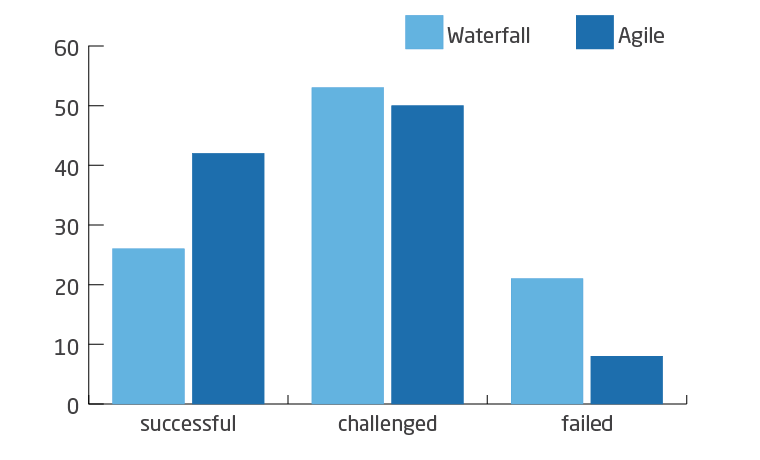Focus on a solution – Waterfall
The Waterfall approach is based on a relatively well-defined plan and established the project framework. They are the result of a defined functional scope of the planned product and the total estimated cost of work.
This approach defines your detailed solution expectations. These are treated as binding and taken as a starting point for the implementation of the project. Changes to the scope are usually based on an extensive change management process.
Focus on a business goal – Agile
Agile is more flexible. Its main goal is to adapt the product to changing business environment conditions. These include primarily: market dynamics, new circumstances discovered during the implementation of tasks, or expectations change.
The key is to define the business goal and then, in close cooperation with the contractor, create a vision of the solution. Verification and redefinition of adopted assumptions constitute a natural part of the project here. The goal of these activities is to maximize the business value of the product and minimize the risk associated with uncertainty in market circumstances.
Waterfall vs Agile
Both approaches are valuable, but in some types of projects, better Waterfall works better, and in others Agile. Below you’ll find a list of key factors that can help you to choose the best approach.
| Waterfall | Agile | |
| Project type | I need to implement a relatively small project with strictly defined assumptions. | The project I am implementing requires constant adaptation to changing circumstances. |
| Project assumptions | I know what the final project’s product will look like. | The final product will be the result of adaptation to identified business circumstances. |
| Budget | The budget of a project or its stage takes into account the contractor’s project risk. It is settled in the Fixed Price model. | Expenses are focused on the value of the delivered project maximization. Settlement in the Time & Material model. |
| Scope | I need to define the product functionalities in detail. | I can iteratively reach the final shape of functionality. |
| Planning | All the actions are the result of established project assumptions. | Business circumstances shape the product development plan. |
| Monitoring and controlling | I can control the progress of work against the schedule. | I control the progress of works by verifying the regularly provided increased product value. |
| Change management | I can afford time-consuming change management. | I need flexibility in making changes. |
| Executive approach | The team performs precisely defined tasks. | The development team is actively involved in defining solutions. |
| Implementation approach | I need to work based on specific project implementation processes. | The implementation process of project development is dynamically shaped by the team. |
What do the statistics say?
PROJECT SUCCESS RATES
WATERFALL VS AGILE

www.vitalitychicago.com Source: Standish Group Chaos Studies 2013-2017
Statistics data shows that Agile projects are more often successful. However, it is worth to remember, that each project is a unique resultant of business vision and circumstances. Therefore, the choice of project management approach should be considered in terms of profit maximization and quickly obtaining a return on investment while minimizing the risk taken.
If you want to get more information, please contact us.
Write to us